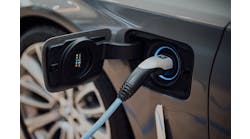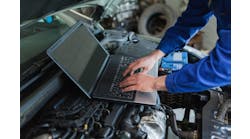According to a recent report from IHS Automotive, worldwide production of electric vehicles (EVs) is expected to rise by 67 percent this year. That brings the total number of either fully electric or plug-in hybrid electric vehicles to 400,000 vehicles, up from 240,000 in 2013.
That huge increase in the EV market this year is coupled with the 3.6 percent rise in global manufacturing of all motor vehicles expected in 2014.
Although the EV market continues to rise, there are still a number of challenges that have thus far prohibited EVs from entering the mass market.
Ben Scott is an analyst for IHS Automotive and specializes in hybrid and electric vehicles. He recently spoke with Ratchet+Wrench to discuss the state of alternative propulsion systems in 2014, current challenges, and what shops can do now to prepare themselves for future uptake.
What kind of electric vehicles are offered in the market today?
In our forecast, we cover all the alternative propulsion systems, all the way from a micro hybrid to a pure electric vehicle. At the very bottom end, we have a micro hybrid, which isn’t a true hybrid in the traditional sense. By micro hybrid, we mean a normal internal combustion engine vehicle that has a start/stop system on it.
If we go up another stage, we have the mild hybrid. As an example, that’s the Honda Insight. In these vehicles, there’s a battery and an electric motor, which helps the internal combustion propel the vehicle.
We then go onto the full hybrid, such as the Prius, where you have a battery pack and an electric motor that can propel the car by itself at lower speeds.
We then have a plug-in version of that, where you can basically plug your Prius in a wall outlet or public charging station and recharge the battery pack.
Going one step from there, we have the pure electric vehicles. These are your Nissan Leafs, your BMW i3s. There is no sort of internal combustion engine on that vehicle; it’s all battery powered or electric motor powered.
In terms of those types of vehicles, in 2014, we’re expecting to see 243,000 electric vehicles, 153,000 plug-in hybrids, and 2 million non-plug-in hybrids.
Are electric vehicles starting to become more mass market?
Vehicle availability is absolutely critical for the uptake of these kinds of vehicles. If I bought an internal combustion vehicle right now, there are literally hundreds I could choose from. Whereas if I wanted to choose an electric or even hybrid vehicle, there are less than 50 models. There needs to be some sort of parity between alternative propulsion vehicles and internal combustion vehicles.
I think this year will be very important in bringing more vehicles to the market. Toward the back end of last year, we’ve seen the BMW i3, the Volkswagen e-Golf and e-Up. We will see significant sales of those models this year. Audi has the A3 e-tron and Ford has the C-MAX Energi coming in 2014. That’s going to help with consumer choice and availability.
What’s driving the production surge?
I think a lot of it has to do with legislation and CO2 reduction. I think if CO2 wasn’t an issue, we’d still make gasoline or diesel cars with no trouble. But because of legislation around the world to bring CO2 down, OEMs are forced to produce these vehicles.
What are the current challenges with electric vehicles?
We do have these sorts of vehicles out there to buy, but one of the main reasons these vehicles haven’t sold as well as once thought is because the price is still quite high. I could go buy an electric vehicle now, but for more or less the same price, I could buy a BMW 3 Series. The choice is quite simple on that one. People need to see a price on paper with parity of internal combustion vehicles or even lower.
Another aspect of this is that consumers need to be confident with the technology and confident with these sorts of vehicles. I think once more people start seeing these vehicles on the road, there’ll be more of an acceptance with these types of vehicles.
Will prices decrease this year?
If you compared the 2012 Nissan Leaf version to today’s version, the price has dropped around $6,000. The Volt has also decreased in price. I’m not sure if that’s a ploy to get more people to buy them or they’ve managed to cut down the production costs of these vehicles.
I think price still needs to come down a little bit more. A lot of people don’t take into consideration the entire lifetime costs. With an electric vehicle, you’re obviously not paying for fuel, charging your car at home is very cheap. People need to look at the entire lifetime cost, rather than the on-paper price.
Will we see any drop in the price of lithium-ion batteries?
Obviously the consumer electronic space has really helped with lithium-ion technology. That technology has been carried over into the automotive world. Battery prices are still quite high and it makes up the majority of the price of a vehicle. If you take the Tesla Model S, most of the cost and the weight is the battery itself.
At the moment, for a price per kilowatt-hour, we’re probably around the $300 mark. Most EVs with large batteries have capacities of roughly 40 kilowatt hours.
But once we get below that $250 mark per kilowatt hour, that is the generally accepted price level for these batteries to become mass market. I think that will really help the market and help drive down costs of these vehicles.
There are quite a few players in this market. Those companies—like Samsung, LG Chem, and Panasonic—are in a price war. In turn, that is decreasing lithium-ion battery prices.
When do shops need to be ready to work on EVs?
Market share for these vehicles is still at the less than 1 percent mark. That being said, some OEMs have celebrated recent milestones. The Nissan Leaf sold 100,000 units worldwide and Tesla sold around 24,000 Model S vehicles in 2014.
OEMs realize they’re in this game for the long term. Beyond 2020 is when we might see significant uptake on these vehicles. It’s good that shops are getting ready now but I think it’s going to take a little bit of time for more of these vehicles to make a significant impact.
What do shops need to do now to start preparing?
I think actually having a charging station is of paramount importance. If that’s not possible, pre-wiring your shop is also a good idea.
Also there will be some retooling as well for shops, for some of the components that are involved. First of all, there’s less moving parts in the engine bay and also there are more electronic systems. You’d see things in the power train like DC-DC converters, inverters, batteries, and battery management systems.
I think there also needs to be more education there as well. I think people who work on these vehicles need to consider the electronic content. Having an electronic engineering background or at least knowing something about electronics will become extremely important, rather than the traditional mechanic that we see now.



